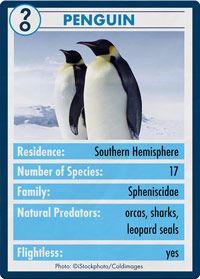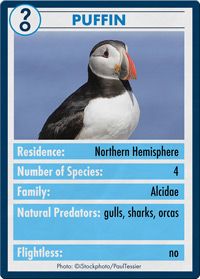Penguins and Puffins: The Situation Isn't Just Black and White
If you think that penguins and puffins perch atop a close set of branches on the avian family tree, think again. Genetically, penguins and puffins aren't siblings or even cousins. Penguins belong to the family Spheniscidae, while puffins are members of the family Alcidae. There are 17 different species of penguin and four species of puffin, without any overlap. In fact, they aren't even geographical neighbors. Puffins reside in the Northern Hemisphere, with about 60 percent of the global puffin population residing in Iceland [source: Project Puffin]. You'll find penguins on the other side of the world living throughout the Southern Hemisphere, from Antarctica to South America.

But the clearest distinction between these animals is flight. Puffins, which are much lighter and more compact, can fly. Thanks to penguins' chubby bodies and rigid wings, they're permanently grounded. To understand why that is, let's compare their sizes. You could easily tote a puffin around for a day since they weigh slightly more than a pound (0.45 kilograms) [source: Street and Emily]. On the other hand, carrying an emperor penguin that tips the scale at around 66 pounds (30 kilograms) would be like hauling hefty luggage.
Advertisement
If penguins can't fly, why do they have wings? Penguins' wings serve as underwater flippers to propel them hundreds of feet below the surface of the water. That's a beneficial trait, since penguin diets consist of fish and small crustaceans. During seasonal migrations, penguins get around by swimming instead of flying like their feathered friends. Penguins could give Michael Phelps a run for his money as well, with some able to swim faster than 20 mph (32 kph) [source: HowStuffWorks].
Puffins have a comparable diet to penguins, mostly consisting of small fish such as herring, hake and capelin. They propel themselves in water with their wings, just like penguins, but only dive under for 20 to 30 seconds at a time [source: Project Puffin]. While they may not swim as deep as penguins, puffins can stuff an impressive load of fish into their mouths to take back to their chicks. The roofs of their mouths are covered with small spikes to snag fish, allowing a record-setting puffin to jam 62 fish inside its beak at once [source: Taylor].
So who wins in the match-up between flying puffins and diving penguins? Until a penguin takes to the air, or a puffin performs underwater acrobatics, we'll have to call it a draw. Like bagels and doughnuts, you can't really judge which reigns supreme.
Related HowStuffWorks Articles
More Great Links
- AnimalPlanet.com
- Project Puffin
- Animal Diversity Web: Penguins
- Earth Guide: Penguins
Sources
- Bukaty, Robert F. "Penguin-like puffins resurface in Maine." Associated Press. MSNBC. Aug. 30, 2007. (Aug. 14, 2008)http://www.msnbc.msn.com/id/20462551/
- Gaskell, Jeremy. "Who Killed the Great Auk?" Oxford University Press. 2000. (Aug. 14, 2008)http://books.google.com/books?id=tsUzeXV_7jcC
- "Penguin." HowStuffWorks. (Aug. 14, 2008) https://animals.howstuffworks.com/birds/penguin-info.htm/printable
- "Puffin Questions." Project Puffin. (Aug. 14, 2008)http://www.projectpuffin.org/questions.html
- Reynolds, K. "Eudyptes chrysolophus." Animal Diversity Web. 2001. (Aug. 14, 2008) http://animaldiversity.ummz.umich.edu/site/accounts/information/Eudyptes_chrysolophus.html
- Street, R. and A. Emily. "Fratercula arctica." Animal Diversity Web. 1999. (Aug. 14, 2008) http://animaldiversity.ummz.umich.edu/site/accounts/information/Fratercula_arctica.html
- Taylor, Kenneth. "Puffins." National Geographic. January 1996.
- "What makes a penguin a penguin?" Earth Guide. Scripps Institution of Oceanography. (Aug. 14, 2008)http://earthguide.ucsd.edu/penguins/penguin.html
